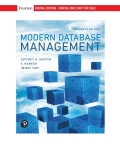
EBK MODERN DATABASE MANAGEMENT,
13th Edition
ISBN: 9780134792279
Author: TOPI
Publisher: YUZU
expand_more
expand_more
format_list_bulleted
Concept explainers
Question
Chapter 10, Problem 10.23PAE
Program Plan Intro
(a)
Procedure between ‘Input and Input’
Program Plan Intro
(b)
The purpose of the shuffle stage.
Program Plan Intro
(c)
The role of Reduce stage if the overall goal is to count the numbers of instances per goal.
Expert Solution & Answer
Want to see the full answer?
Check out a sample textbook solution
Students have asked these similar questions
I need to define and discuss the uses of one monitoring or troubleshooting tool in Windows Server 2019. thank you
I would likr toget help with the following concepts:
- Windows Server features
- Windows Server versus Windows 10 used as a client-server network
I need to define and discuss the uses of one monitoring or troubleshooting tool in Windows Server 2019. thank you
Chapter 10 Solutions
EBK MODERN DATABASE MANAGEMENT,
Ch. 10 - Prob. 10.1RQCh. 10 - Prob. 10.2RQCh. 10 - Prob. 10.3RQCh. 10 - Prob. 10.4RQCh. 10 - Prob. 10.5RQCh. 10 - What are the two main categories of technologies...Ch. 10 - Prob. 10.7RQCh. 10 - Prob. 10.8RQCh. 10 - Prob. 10.9RQCh. 10 - Prob. 10.10RQ
Ch. 10 - Prob. 10.11RQCh. 10 - Prob. 10.12RQCh. 10 - Prob. 10.13RQCh. 10 - Prob. 10.14RQCh. 10 - Prob. 10.15RQCh. 10 - Prob. 10.16RQCh. 10 - Prob. 10.17RQCh. 10 - Prob. 10.18PAECh. 10 - Prob. 10.19PAECh. 10 - Prob. 10.20PAECh. 10 - Prob. 10.21PAECh. 10 - Prob. 10.22PAECh. 10 - Prob. 10.23PAECh. 10 - Prob. 10.24PAECh. 10 - Prob. 10.25PAECh. 10 - Prob. 10.26PAECh. 10 - Consider the customer table created in Figure...
Knowledge Booster
Learn more about
Need a deep-dive on the concept behind this application? Look no further. Learn more about this topic, computer-science and related others by exploring similar questions and additional content below.Similar questions
- Please solve and answer the questions correctly please. Thank you!!arrow_forwardConsidering the TM example of binary sum ( see attached)do the step-by-step of execution for the binary numbers 1101 and 11. Feel free to use the Formal Language Editor Tool to execute it; Write it down the current state of the tape (including the head position) and indicate the current state of the TM at each step.arrow_forwardI need help on inculding additonal code where I can can do the opposite code of MatLab, where the function of t that I enter becomes the result of F(t), in other words, turning the time-domain f(t) into the frequency-domain function F(s):arrow_forward
arrow_back_ios
SEE MORE QUESTIONS
arrow_forward_ios
Recommended textbooks for you
- Np Ms Office 365/Excel 2016 I NtermedComputer ScienceISBN:9781337508841Author:CareyPublisher:CengageCOMPREHENSIVE MICROSOFT OFFICE 365 EXCEComputer ScienceISBN:9780357392676Author:FREUND, StevenPublisher:CENGAGE L
 C++ for Engineers and ScientistsComputer ScienceISBN:9781133187844Author:Bronson, Gary J.Publisher:Course Technology Ptr
C++ for Engineers and ScientistsComputer ScienceISBN:9781133187844Author:Bronson, Gary J.Publisher:Course Technology Ptr  New Perspectives on HTML5, CSS3, and JavaScriptComputer ScienceISBN:9781305503922Author:Patrick M. CareyPublisher:Cengage Learning
New Perspectives on HTML5, CSS3, and JavaScriptComputer ScienceISBN:9781305503922Author:Patrick M. CareyPublisher:Cengage Learning Database Systems: Design, Implementation, & Manag...Computer ScienceISBN:9781305627482Author:Carlos Coronel, Steven MorrisPublisher:Cengage Learning
Database Systems: Design, Implementation, & Manag...Computer ScienceISBN:9781305627482Author:Carlos Coronel, Steven MorrisPublisher:Cengage Learning

Np Ms Office 365/Excel 2016 I Ntermed
Computer Science
ISBN:9781337508841
Author:Carey
Publisher:Cengage

COMPREHENSIVE MICROSOFT OFFICE 365 EXCE
Computer Science
ISBN:9780357392676
Author:FREUND, Steven
Publisher:CENGAGE L

C++ for Engineers and Scientists
Computer Science
ISBN:9781133187844
Author:Bronson, Gary J.
Publisher:Course Technology Ptr


New Perspectives on HTML5, CSS3, and JavaScript
Computer Science
ISBN:9781305503922
Author:Patrick M. Carey
Publisher:Cengage Learning

Database Systems: Design, Implementation, & Manag...
Computer Science
ISBN:9781305627482
Author:Carlos Coronel, Steven Morris
Publisher:Cengage Learning